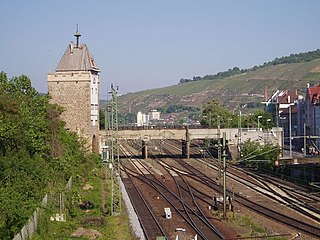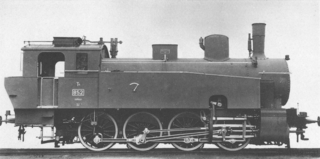
Under the Whyte notation for the classification of steam locomotives, 2-12-0 represents the wheel arrangement of two leading wheels on one axle, twelve powered and coupled driving wheels on six axles, and no trailing wheels.

Geislingen an der Steige is surrounded by the heights of the Swabian Alb and embedded in 5 beautiful valleys. It is a town in the district of Göppingen in Baden-Württemberg in southern Germany. The name relates to its location "on the climb" of a trade route over the Swabian Jura mountain range. It is in the southeast of the Stuttgart region about 50 km of Stuttgart and 27 km of Ulm. It is the second largest city in the district of Göppingen. The city is characterized by a grown industry and attractive surroundings of the Swabian Albtrauf adventure region - this creates a positive environment for regionally and internationally oriented companies. Geislingen's economic significance lies above all in the steel and metal goods processing and automotive supply sectors.

Amstetten is a municipality in Alb-Donau-Kreis, 20 kilometers north-west of Ulm in Baden-Württemberg, Germany.

The Fils Valley Railway designates the Württemberg line from Stuttgart via Göppingen to Ulm. It runs from Plochingen to Geislingen an der Steige through the Fils Valley.

Ulm Hauptbahnhof is the main station in the city of Ulm, which lies on the Danube, on the border of the German states of Baden-Württemberg and Bavaria in the Danube-Iller region.

The German Steam Locomotive Museum or DDM is located at the foot of the famous Schiefe Ebene ramp on the Ludwig South-North Railway in Neuenmarkt, Upper Franconia. This region is in northern Bavaria, Germany. The DDM was founded in 1977.

The Prussian T 18 was the last class of tank locomotives developed for the Prussian state railways. They were originally intended for services on the island of Rügen as replacements for Class T 12 and T 10 engines. They emerged when a class of locomotive was conceived in 1912 that was to handle express and passenger trains in border areas or in shuttle services on short routes. A tank engine design with symmetrical running gear was envisaged because, unlike a tender locomotive, it could run equally fast forwards and backwards and could be operated on return journeys without having to be turned on a turntable. Its power and top speed were to be the same as those of the P 8. Robert Garbe designed this 4-6-4 (2′C2′) tank locomotive for 100 km/h with a 17-ton axle load and contracted the Vulkan Werke in Stettin to build it. It was given the designation T 18.

The Ulm Railway Society is a German society for encouraging the preservation of historically valuable railway stock. It is based in the vicinity of Ulm, a city in the state of Baden-Württemberg in southern Germany. The society was founded in 1969, has about 600 members and around 12 steam locomotives as well as numerous historical wagons.

The Württemberg Class K steam locomotives of the Royal Württemberg State Railways were the only twelve-coupled locomotives built for a German railway company.

The Schiefe Ebene is a steep incline on Bamberg–Hof section of the Ludwig South-North Railway in the region of Upper Franconia, in Bavaria, Germany.

The German DRG Class 95 was a ten-coupled tank locomotive with a 2-10-2 wheel arrangement, which was procured by the Deutsche Reichsbahn in 1922 for hauling heavy goods trains on steep main lines. Because the development of this class was begun by the Prussian state railways, it was designated as the Prussian Class T 20.

The Württemberg T 4 was a class of German, eight-coupled, goods train, tank locomotive operated by the Royal Württemberg State Railways.

The Spessart Ramp is a 5.4 km long incline on the Main-Spessart Railway in southern Germany between Laufach at one end and the Schwarzkopf tunnel and Heigenbrücken at the other, with an average incline of 20 ‰. The ramp is part of Ludwig's Western Railway and the section from Würzburg via Aschaffenburg to the state border at Kahl am Main was opened on 1 October 1854 by the Royal Bavarian State Railways. The ramp enabled the difference in height between the Laufach valley and the Lohr valley to be overcome as it crossed the Spessart between Kahl am Main and Aschaffenburg on the one side and Würzburg/Bamberg on the other.

The Ulm–Sigmaringen railway is a 92.670-kilometre-long railway in Baden-Württemberg in south-western Germany, which is largely single-tracked and for the most part not electrified. It runs from Ulm via Blaubeuren and Riedlingen to Sigmaringen mostly in the valley of the Danube. The line is part of the once important long-distance connection from Munich to Freiburg im Breisgau.

Geislingen (Steige) station is located at the 61.3 kilometre point of the Fils Valley Railway in the German state of Baden-Württemberg. Until May 2000, there was a connection for freight to Geislingen-Altenstadt, a remnant of the former railway to Wiesensteig. The station is served by intercity and regional services.
Mozart was an express train that linked Paris with Vienna via Strasbourg, Stuttgart and Munich. The service began in 1954, as an F-Zug running between Strasbourg and Salzburg, before being extended ten years later. In 1983 it was re-classified as an FD-Zug and it was added to the EuroCity network in 1989. It operated until 2007, when it was replaced by a TGV service on the newly opened LGV Est. It was named after the composer Wolfgang Amadeus Mozart, and served many cities with which he had an association.

Amstetten (Württemberg) station is located at line-kilometre 67.0 on the Fils Valley Railway (Filstalbahn) in Amstetten in the German state of Baden-Württemberg. It is at the top of the Geislinger Steige. The Amstetten–Gerstetten Local Railway and the narrow gauge railway to Oppingen start here. No scheduled passenger services now run on either line. Deutsche Bahn treats the whole station as having three precincts for operational purposes. Amstetten (Württ) Lokalbahnhof is operated as a section of the station, while Amstetten (Württ) (Schmalspurbahn) is operated as a separate station.

Tälesbahn is a standard gauge railway in Baden-Württemberg.

















